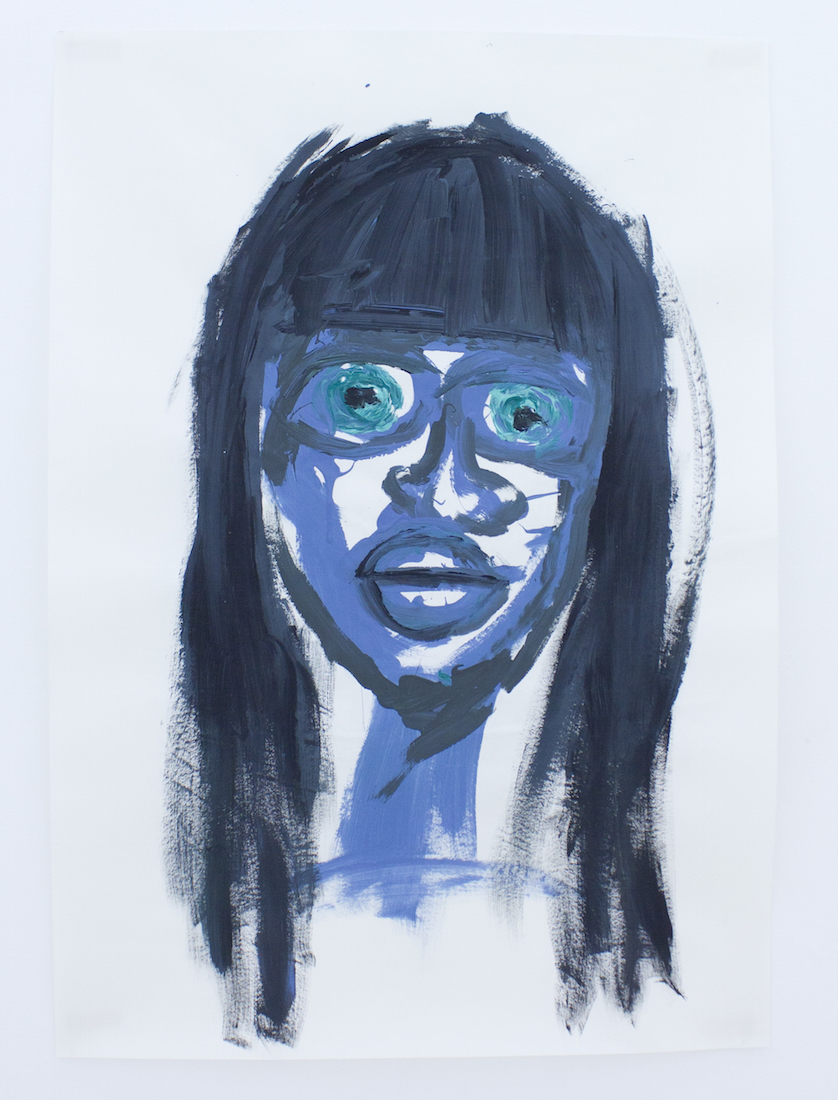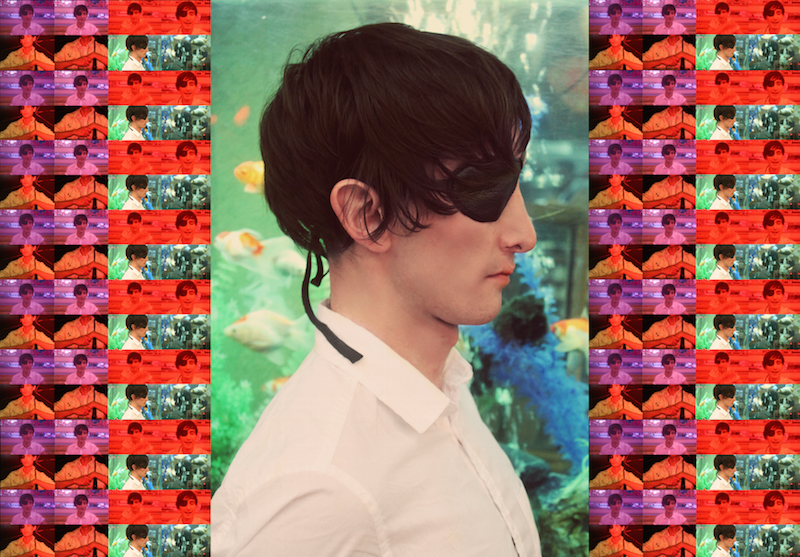“I can’t have control over what my work looks like, and I have to struggle with that every day,” says Manuel Solano, sitting in his studio in Ciudad Satélite, a suburban area in northwest Mexico City. “To make something and not be able to see it, it’s very painful to me.”
Working across painting, performance, and video, the 28-year-old Mexican artist has built an intimate, often playful, universe of pop culture references and queer imagery. A successful exhibition at Karen Huber Gallery last summer put him at the forefront of Mexico City’s emerging art scene, and his work has since been acquired by the Institute of Contemporary Art, Miami. Punchis Punchis Punchis Pum Pum Punchis Punchis Punchis, his first museum solo show, at the capital’s Carrillo Gil Museum, presents works on paper produced after he lost his sight in 2014, following a severe HIV-related infection.

The show’s title, which appears in the exhibition scribbled on a piece of paper torn from a diary, is also a derisive onomatopoeic phrase used by an older generation of Mexicans to refer to electronic music. “I thought that was it, my life was over,” muses Solano, who was well-known in Mexico City’s nightlife circles, “but then I tried to get my social life back and I found myself on several occasions standing in a group of people at a party, pretending to dance but not knowing what’s going on. If I’m going to be blind, I need to make it work, I need to make it liberating.”
The paintings in the show come from the “Blind Transgender with AIDS” series, which Solano made only weeks after losing his eyesight. His friend, the American artist Andrew Birk, had encouraged him to keep painting, no matter what the results looked like. Solano found cheap newsprint paper and covered it in white paint to contrast with the bright colors that he can perceive, sometimes, in certain light conditions. Infused with pop-song lyrics, references to washed-up celebrities, and comical situations, each work in the series took no more than 20 minutes to make, giving them a raw and powerful feel. One piece reads, in big black letters, “making shit paintings just because I can.” “I took blindness as an excuse to make bad paintings,” says Solano, “I couldn’t paint the way I did. I thought whatever I could paint would be a joke on what came before.”

In contrast, some of the artist’s early works were incredibly detailed. “I spent six months on this one oil painting, which in this day and age is crazy!” he laughs. “That’s how I liked it though, I enjoyed being very slow.”
Later though, in 2012, he started to experiment with “unlearning painting” while on an exchange programme at the ENSBA school of art and design in Lyon. He had come across the Divine David’s Art Masterclass on YouTube, in which British queer performer David Hoyle literally throws paint and ketchup onto a canvas as an introduction to portraiture. “I was hypnotized by it, I’d watch it day after day,” Solano explains. Inspired by Hoyle’s satirical style, he made portraits of Naomi Campbell and Nicki Minaj with a deliberately naïve quality to them — which didn’t go down well at his French art school critiques. “They were irritated that my references were coming from outside of art,” recalls Solano. “My reaction, whenever someone tells me something I do is wrong, was always to rebel. I’d like to think now that these portraits have similarities with my more recent paintings.”

That same year, Solano reenacted Sinead O’Connor’s 1992 appearance on Saturday Night Live, in which she sang an a cappella version of Bob Marley’s “War” and tore up a picture of Pope John Paul II. The performance, titled The Victory of Good Over Evil, was televised by French channel CAP Canal, 20 years after O’Connor’s original segment. “I was terrified to shave my head for it and to look more masculine,” recounts Solano, who today identifies as transgender. “But it turned out to be [the period] in my life when I was misgendered most regularly. I would go to the supermarket and be called mademoiselle — they just thought I was a lesbian!” A recording of the performance was on display at this year’s Zona Maco art fair in Mexico City, where Solano had a solo presentation. “I’d never felt like I’d made a piece that was so intimately related to me. I do want to write Sinead O’Connor a letter, but I don’t have the courage yet,” explains the artist.
The Victory of Good Over Evil, 2012
Solano only started to identify as transgender when he came back from France, though he’s questioned his gender identity for as long as he can remember. “When I was four, I kept asking my mom when my penis would fall off!” he recalls. And it didn’t take long for pop culture to enter his world. “I remember seeing this one portrait of Michael Jackson and thinking, ‘That is what I want to be.’ I thought he was extremely beautiful, it was his androgyny.” But losing the ability to see has shifted the artist’s sense of self. “Throughout my life, whenever I had the control, I worked towards ambiguity and to eliminate the maleness in me. It’s been one of the toughest challenges after sickness and blindness,” he says. “Now that I can’t see myself, I feel like I’ve lost my grip on who I am.”
In addition to his recent paintings, and a performance project called Sigourney Weaver — a made-up rock band led by Solano — the artist has been experimenting with sculpture lately. “I’m lost with it! It’s the thing I’ve done the least,” he laughs, “But I really enjoy it, because it’s something I can shape with my hands. I have more control with it.” Regardless of the medium though, or the amount of detail, there’s still a strong sense of continuation between Solano’s pieces. “The main thing for me was realizing that all my life I’d been interested in the same things: pop culture, femininity, my self-identity addressed through these things… And silliness.”
“Punchis Punchis Punchis Pum Pum Punchis Punchis Punchis” runs until August 7 at Museo de Arte Carrillo Gil, Mexico City.
museodeartecarrillogil.com
Credits
Text Benoit Loiseau
Portrait Manuel Diaz Lira
Works courtesy of the artist and Karen Huber Gallery
